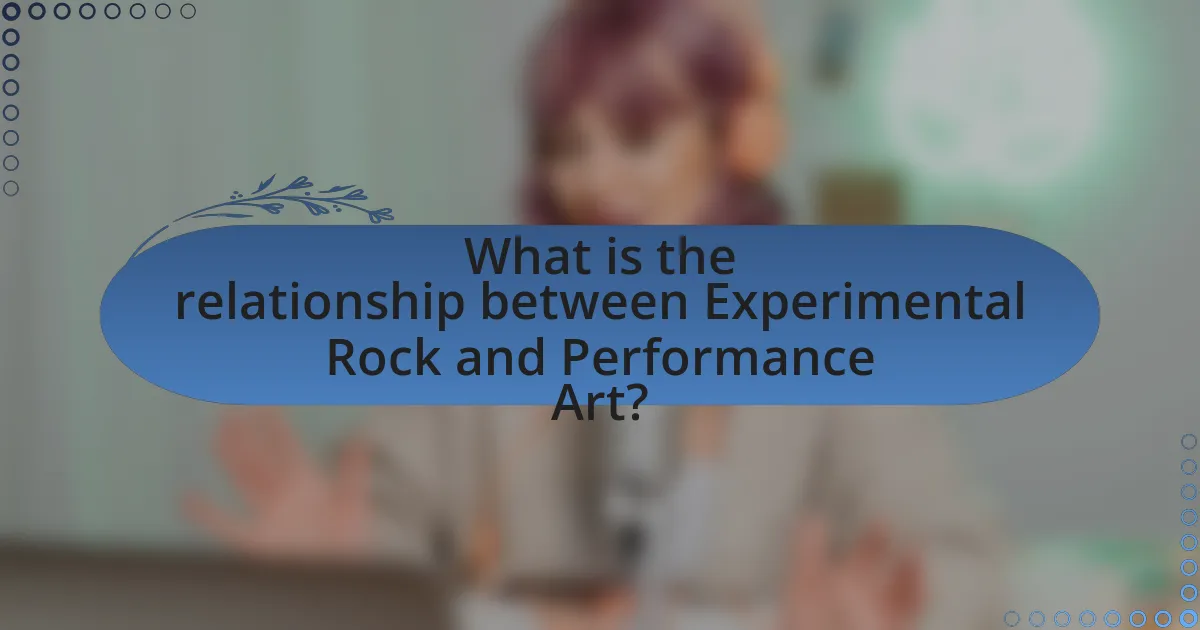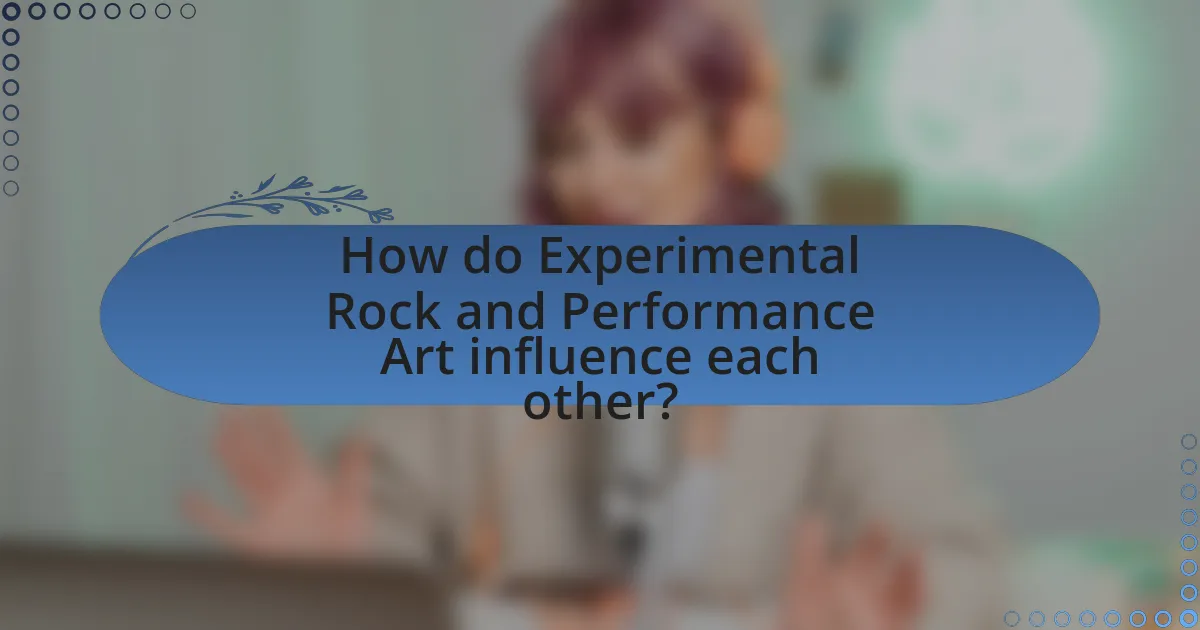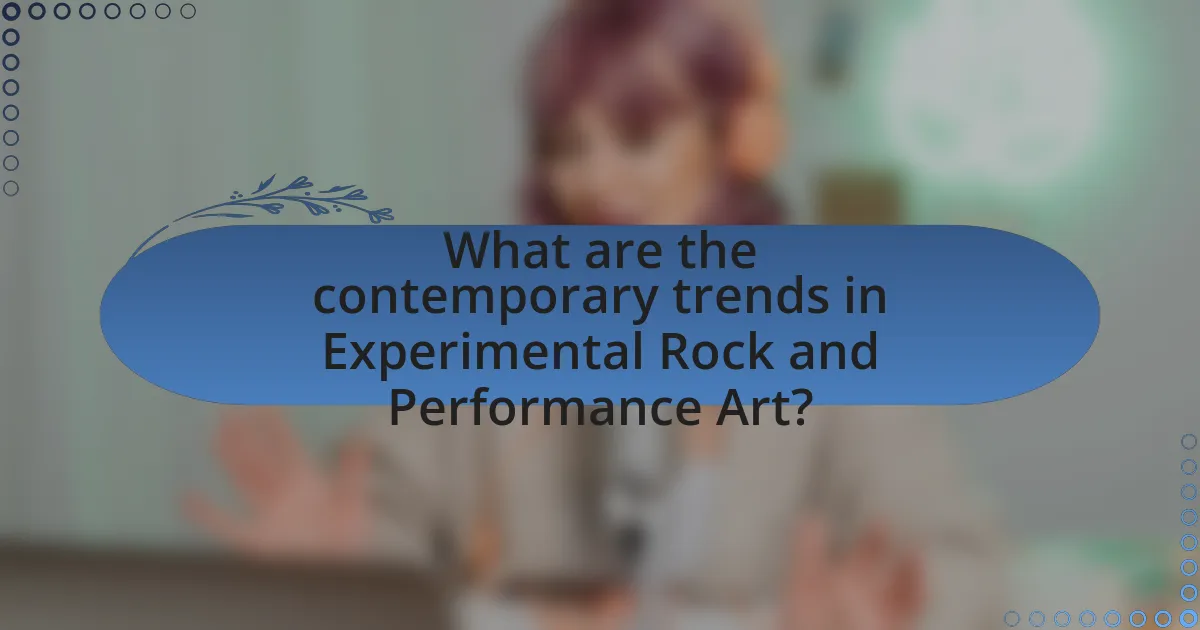The article explores the intricate relationship between Experimental Rock and Performance Art, highlighting their shared focus on innovation and the integration of diverse artistic mediums. It examines the emergence of Experimental Rock in the 1960s, its defining characteristics, and the historical influences that shaped the genre. The article also discusses how Performance Art enhances the auditory experience of Experimental Rock through visual and theatrical elements, providing notable examples of artists who successfully merge these forms. Additionally, it addresses contemporary trends, the impact of technology, and the importance of collaboration between musicians and performance artists, while offering practical tips for effectively combining these two dynamic art forms.

What is the relationship between Experimental Rock and Performance Art?
Experimental Rock and Performance Art are interconnected through their shared emphasis on innovation, boundary-pushing, and the integration of various artistic mediums. Both forms challenge traditional norms; Experimental Rock often incorporates unconventional sounds and structures, while Performance Art utilizes the body and live action to convey artistic expression. Historical examples include artists like Laurie Anderson, who blends music with theatrical performance, illustrating how these genres can coexist and enhance each other. This relationship highlights a mutual exploration of creativity, where the auditory experience of Experimental Rock complements the visual and experiential aspects of Performance Art.
How did Experimental Rock emerge as a genre?
Experimental Rock emerged as a genre in the 1960s, characterized by its innovative approach to music that challenged traditional rock norms. This genre developed as artists sought to explore new sounds, structures, and concepts, often incorporating elements from avant-garde music, jazz, and electronic experimentation. Key figures such as The Velvet Underground and Frank Zappa pushed boundaries by integrating unconventional instrumentation and performance techniques, which laid the groundwork for future experimental musicians. The genre’s evolution was further influenced by the counterculture movement, which embraced artistic freedom and nonconformity, leading to a diverse range of styles and expressions within Experimental Rock.
What are the defining characteristics of Experimental Rock?
Experimental Rock is characterized by its innovative approach to music, often incorporating unconventional structures, sounds, and techniques. This genre frequently blends elements from various musical styles, including jazz, electronic, and avant-garde, resulting in a unique auditory experience. Artists in Experimental Rock often utilize non-traditional instruments, extended improvisation, and studio manipulation, which can lead to unexpected sonic textures. The genre also emphasizes artistic expression and conceptual themes, often challenging the norms of mainstream music. Notable examples include bands like The Velvet Underground and Radiohead, who have pushed boundaries and influenced the evolution of music through their experimental techniques.
How has the history of music influenced Experimental Rock?
The history of music has significantly influenced Experimental Rock by introducing diverse genres, innovative techniques, and avant-garde concepts. Influential movements such as jazz, classical, and electronic music have provided a foundation for Experimental Rock artists to explore unconventional structures, sounds, and instrumentation. For instance, the incorporation of free jazz improvisation and electronic manipulation can be traced back to the works of composers like John Cage and musicians like Ornette Coleman, who challenged traditional musical boundaries. This historical context has enabled Experimental Rock to evolve as a genre that prioritizes artistic expression and exploration over commercial viability, leading to the creation of landmark albums like “The Velvet Underground & Nico” and “OK Computer,” which exemplify the genre’s roots in historical musical experimentation.
What role does Performance Art play in the context of Experimental Rock?
Performance Art serves as a crucial element in Experimental Rock by enhancing the auditory experience with visual and theatrical components. This integration allows artists to challenge traditional music norms, creating immersive environments that engage audiences on multiple sensory levels. For instance, bands like The Velvet Underground and later performers such as David Bowie and Laurie Anderson incorporated performance art techniques, using costumes, multimedia, and narrative to deepen the impact of their music. This blending of disciplines not only expands the artistic expression within Experimental Rock but also invites audiences to interpret the music through a broader cultural lens, thus enriching the overall experience.
How do artists integrate Performance Art into their music?
Artists integrate Performance Art into their music by incorporating theatrical elements, visual storytelling, and interactive experiences during live performances. This integration often involves the use of elaborate stage designs, costumes, and choreography that enhance the emotional and conceptual depth of the music. For example, artists like David Bowie and Björk have utilized performance art to create immersive environments that reflect the themes of their songs, thereby transforming a concert into a multi-sensory experience. The blending of these art forms allows musicians to engage audiences on a deeper level, making the performance not just a musical event but a holistic artistic expression.
What are some notable examples of this integration?
Notable examples of the integration between experimental rock and performance art include the works of artists like Laurie Anderson, whose multimedia performances blend storytelling, music, and visual art, and the band The Velvet Underground, known for their avant-garde approach and theatrical live shows. Additionally, David Bowie’s Ziggy Stardust persona exemplifies this fusion, combining rock music with theatrical elements and visual spectacle. These examples illustrate how experimental rock artists have utilized performance art techniques to enhance their musical expression and engage audiences in innovative ways.

How do Experimental Rock and Performance Art influence each other?
Experimental Rock and Performance Art influence each other through their shared emphasis on innovation, audience engagement, and the breaking of traditional boundaries in artistic expression. Experimental Rock often incorporates theatrical elements, visual art, and multimedia presentations, which are hallmarks of Performance Art. For instance, artists like David Bowie and Frank Zappa blurred the lines between music and performance, creating immersive experiences that challenge conventional concert formats. Conversely, Performance Art has adopted musical elements, as seen in the works of artists like Marina Abramović, who integrates sound and rhythm into her performances, enhancing the emotional impact. This reciprocal relationship fosters a dynamic environment where both forms continually evolve, pushing the limits of creativity and audience interaction.
What are the common themes found in both Experimental Rock and Performance Art?
Common themes found in both Experimental Rock and Performance Art include the exploration of identity, the challenge of traditional norms, and the use of multimedia elements. Both forms prioritize innovation and often seek to provoke thought and emotional responses from their audiences. For instance, artists in Experimental Rock frequently experiment with sound and structure to convey complex themes, while Performance Art utilizes the body and space to express similar ideas. This intersection is evident in the works of artists like Laurie Anderson, who blends music and performance to explore personal and societal narratives, demonstrating the shared commitment to pushing boundaries and engaging audiences in new ways.
How do these themes manifest in live performances?
Themes in experimental rock and performance art manifest in live performances through immersive visual elements, audience interaction, and unconventional soundscapes. For instance, artists often incorporate multimedia projections and elaborate stage designs to create a sensory experience that complements the music. This approach is evident in performances by bands like The Flaming Lips, who utilize vibrant visuals and theatrical elements to engage the audience. Additionally, audience participation is a common theme, as seen in the works of artists like Laurie Anderson, who often invites spectators to become part of the performance, blurring the lines between performer and audience. The use of experimental sound techniques, such as live looping and electronic manipulation, further emphasizes the avant-garde nature of these performances, allowing for a unique auditory experience that challenges traditional music norms.
What impact do they have on audience perception?
Experimental rock and performance art significantly shape audience perception by challenging conventional norms and encouraging active engagement. This genre often blurs the lines between music and visual art, prompting audiences to reconsider their understanding of artistic expression. For instance, performances by artists like Laurie Anderson and David Bowie have utilized multimedia elements to create immersive experiences, which can alter how audiences interpret both the music and the accompanying visuals. Research indicates that such innovative approaches can enhance emotional responses and foster deeper connections with the material, as evidenced by studies showing that audiences exposed to cross-disciplinary art forms report higher levels of engagement and satisfaction.
Why is collaboration important between Experimental Rock musicians and Performance Artists?
Collaboration between Experimental Rock musicians and Performance Artists is important because it fosters innovative artistic expression and enhances audience engagement. Experimental Rock musicians often push the boundaries of sound and structure, while Performance Artists bring visual and physical elements that can transform a musical experience into a multi-sensory event. This synergy allows for the creation of immersive performances that challenge traditional art forms. For instance, the collaboration between musicians like Frank Zappa and performance artists has historically resulted in groundbreaking works that blend music with theatrical elements, demonstrating how such partnerships can lead to unique artistic outcomes.
What are the benefits of such collaborations?
Collaborations between experimental rock and performance art enhance creativity and broaden artistic expression. These partnerships allow artists to merge diverse mediums, resulting in innovative performances that captivate audiences. For instance, the integration of visual elements from performance art into live music can create immersive experiences, as seen in the works of artists like Laurie Anderson, who combines storytelling, music, and visual art. Additionally, such collaborations can expand the reach of both art forms, attracting new audiences and fostering cross-disciplinary dialogue, which is essential for cultural evolution.
How do these collaborations challenge traditional art forms?
Collaborations between experimental rock and performance art challenge traditional art forms by merging distinct mediums, thereby redefining artistic boundaries. This fusion creates immersive experiences that engage audiences in ways conventional art cannot, as seen in performances by artists like Laurie Anderson, who integrates multimedia elements with live music. Such collaborations disrupt established norms by emphasizing spontaneity and audience interaction, which contrasts with the static nature of traditional visual arts. The integration of technology and innovative staging further exemplifies this challenge, as it transforms the perception of both music and visual art, pushing the limits of creativity and expression.

What are the contemporary trends in Experimental Rock and Performance Art?
Contemporary trends in Experimental Rock and Performance Art include the integration of multimedia elements, the use of technology for immersive experiences, and a focus on social and political themes. Artists increasingly blend genres, incorporating electronic music and visual art to create holistic performances that challenge traditional boundaries. For instance, the rise of live-streaming and virtual reality has allowed performers to reach wider audiences while experimenting with new formats. Additionally, many contemporary artists address pressing societal issues, using their platforms to provoke thought and inspire action, as seen in the works of artists like Björk and Laurie Anderson, who utilize innovative techniques to engage audiences on multiple levels.
How has technology influenced the evolution of these art forms?
Technology has significantly influenced the evolution of experimental rock and performance art by enabling innovative sound production and immersive visual experiences. The introduction of electronic instruments, such as synthesizers and drum machines, transformed the soundscapes of experimental rock, allowing artists to explore new musical territories. For instance, the use of tape loops and sampling techniques in the 1960s and 1970s expanded the creative possibilities for musicians, as seen in the works of bands like Pink Floyd and The Velvet Underground.
In performance art, technology has facilitated the integration of multimedia elements, enhancing audience engagement. The use of projection mapping and interactive installations has allowed artists to create dynamic environments that respond to live performances, exemplified by the works of artists like Laurie Anderson and Marina Abramović. Furthermore, advancements in digital technology have made it easier for artists to distribute their work globally, reaching wider audiences through platforms like social media and streaming services. This accessibility has fostered collaboration across disciplines, further blurring the lines between experimental rock and performance art.
What new tools and platforms are being utilized by artists?
Artists are increasingly utilizing digital tools and platforms such as virtual reality (VR), augmented reality (AR), and social media for creative expression and audience engagement. These technologies allow artists to create immersive experiences and reach wider audiences. For instance, platforms like Instagram and TikTok enable artists to showcase their work and connect with fans in real-time, while VR applications like Oculus Medium provide new avenues for 3D art creation. The integration of these tools reflects a shift towards more interactive and participatory art forms, enhancing the relationship between experimental rock and performance art.
How does social media impact the visibility of Experimental Rock and Performance Art?
Social media significantly enhances the visibility of Experimental Rock and Performance Art by providing platforms for artists to share their work with a global audience. This democratization of access allows niche genres to reach potential fans who may not have encountered them through traditional media channels. For instance, platforms like Instagram and YouTube enable artists to showcase performances and experimental music videos, leading to increased engagement and community building. According to a study by the Pew Research Center, 72% of adults use social media, which indicates a vast audience that can discover and support these art forms. Furthermore, social media algorithms often promote content based on user interests, allowing experimental artists to gain visibility through targeted recommendations, thus fostering a more diverse cultural landscape.
What are some emerging artists or groups redefining the relationship between these two fields?
Emerging artists redefining the relationship between experimental rock and performance art include Yves Tumor and the collective 33 1/3. Yves Tumor blends experimental rock with theatrical performance, utilizing visual art and immersive experiences to challenge traditional concert formats. The collective 33 1/3 focuses on interdisciplinary collaborations, merging sound, visual art, and live performance to create innovative experiences that engage audiences in new ways. Their work exemplifies the evolving intersection of these fields, pushing boundaries and redefining audience engagement in contemporary art.
What innovative approaches are they taking?
They are integrating multimedia elements into live performances, creating immersive experiences that blend sound, visuals, and audience interaction. This approach enhances the emotional impact of the music and engages the audience on multiple sensory levels. For instance, artists like Laurie Anderson have utilized video projections and interactive technology to deepen the narrative of their performances, demonstrating how experimental rock can evolve through performance art techniques.
How are they engaging with audiences differently?
Experimental rock and performance art engage with audiences differently by emphasizing immersive experiences and audience participation. Experimental rock often incorporates unconventional soundscapes and visual elements that challenge traditional music formats, creating a multi-sensory experience. In contrast, performance art focuses on the physical presence and interaction of the artist with the audience, often blurring the lines between performer and spectator. For instance, artists like Laurie Anderson utilize technology and storytelling to create a narrative that invites audience reflection, while bands like The Residents employ theatrical elements to provoke emotional responses. This distinction highlights how experimental rock prioritizes auditory innovation, whereas performance art centers on the relational dynamics between the artist and the audience.
What practical tips can artists consider when merging Experimental Rock with Performance Art?
Artists merging Experimental Rock with Performance Art should focus on integrating multimedia elements to enhance the sensory experience. This can include using visual projections, interactive installations, and unconventional stage setups that complement the music. For instance, the use of lighting and video can create an immersive atmosphere, as seen in performances by artists like Laurie Anderson, who blends storytelling with innovative soundscapes. Additionally, artists should experiment with audience interaction, encouraging participation to break the fourth wall, which has been effective in performances by groups like The Residents. This approach not only engages the audience but also transforms the performance into a collaborative experience, making it more dynamic and memorable.
How can artists effectively plan a performance that incorporates both elements?
Artists can effectively plan a performance that incorporates both experimental rock and performance art by integrating multimedia elements, improvisation, and audience interaction. This approach allows for a dynamic experience that reflects the spontaneity of experimental rock while embracing the conceptual depth of performance art. For instance, artists can use visual projections, live painting, or interactive installations to create an immersive environment that enhances the musical experience. Research indicates that performances that blend these elements can lead to heightened audience engagement and emotional resonance, as seen in the works of artists like Laurie Anderson and David Bowie, who successfully merged music with theatrical and visual components.
What are some common pitfalls to avoid in this fusion?
Common pitfalls to avoid in the fusion of experimental rock and performance art include neglecting the integration of sound and visual elements, which can lead to a disjointed experience. This disconnection often results in audiences being unable to fully engage with the performance, diminishing its impact. Additionally, failing to consider the audience’s perception can alienate viewers, as experimental approaches may not resonate with everyone. Historical examples, such as the early works of artists like Laurie Anderson, demonstrate that cohesive storytelling and audience connection are crucial for successful performances. Lastly, overemphasizing technical complexity at the expense of emotional expression can detract from the overall artistic message, as seen in various performances that prioritize avant-garde techniques over relatable themes.